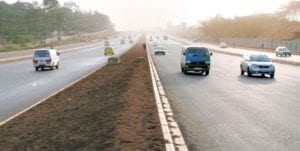After a nearly five years wait, engineers responsible for the reconstruction of Nairobi-Thika Highway are all smiles after conquering one of the most challenging engineering feats, constructing a super highway while it is used by motor and human traffic.
“This is not the standard practice, of doing a major highway when in use by traffic, but we had to do it here because there were no alternative roads to divert traffic,” said Hari Ramesh, Chief Resident Engineer for the 50.4 kilometre highway. Despite the interruptions, Ramesh said delays have been minimal and the quality achieved is that of global standard. “This is a good road even if it was in a country like China or India,” he told Xinhua in a recent interview in Nairobi. But perhaps the most glowing smiles are those worn by road users who have had to endure serious inconveniences as the road construction progressed. Today, a journey that used to take two hours during peak time, usually in the morning and evening, takes less than 20 minutes. Commuters would take up to three hours or more to travel from Thika Town, Kenya’s industrial town to the capital Nairobi. Today that journey takes less than 45 minutes and is expected to reduce to 25 minutes when the construction works are fully finished around December. “We have done 97 percent of the works,” said Song Qinggang, the Deputy Manager of SinoHydro Corporation that is handling one of the three sections of the road. “If it were not for delays in the relocation of services like electricity lines and water pipes, we should have progressed much faster,” he said in an interview. For instance, the company has delayed putting up a pedestrian foot bridge next to the section of the highway at Safari Park Hotel because the electricity lines are on the area set aside for the overpass foot bridge. The other sections of the road are being handled by China Wu Yi and Sheng Li Engineering Company. All are Chinese and won the tender through competitive bidding. The road is part of Kenya’s Vision 2030 blue print that aims at facilitating the country achieve middle income status by the year 2030. It is also part of the greater trans-Africa road meant to connect Egyptian capital Cairo to the South Africa’s sea-side city of Cape Town. The immediate intention of the highway is to ease traffic congestion in the Nairobi metropolitan area in order to increase the pace of doing business in an area that contributes the biggest value to the national economy. The highway is supported by two by-passes, the Eastern Bypass that connects it to another highway known as Mombasa Road, and the Northern Bypass also connecting it to another highway known as Waiyaki Way. All the three form the trio of arteries that service large motor traffic to, from and through the heart of the Nairobi Business District.The ongoing final works of the highway that has been expanded from the previous 4 lanes to 10 lanes in some sections include road marking, putting up pedestrian bridges and landscaping. The contractors are also waiting for power connection from the Kenya Power company to power the highways lighting system.
While commuters have been the biggest gainers in having their travel time lessened, another category of big winners has been the property developers who have had the value of their property rise by up to five times or more as a result of better infrastructure along the 50.4 kilometre highway. Savvy property investors are now cashing on this value by selling their property at much higher price than they bought. Owners of rental properties like apartments have also increased rent. But public service vehicles have been forced to freeze rise in bus fares as the time taken to travel from one point to the other along the road is now shorter, although some of them have used the excuse of volatility in petrol and diesel prices to revise the bus fares upwards. Winners also include local engineers who got a chance to be attached to the project and the engineering profession in general as the project forms one of the best case studies in the construction of roads. The highway is the biggest single such project in Kenya by value and size. Other beneficiaries also include the 3,500 Kenyans who got a chance to work on the project throughout its span period. The project was funded by the Kenya government, Africa Development Bank and China Exim Bank. According to the Kenya National Highways Authority (KENHA), the previous four lane road was constructed in the early 1970s. It has since been operating beyond its capacity, handling an estimated 60, 000 vehicles every day prompting need for its expansion. Source: http://allafrica.com







